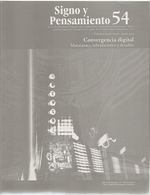Abstract
Since information society’s dawn, a steady process of digitization has been transforming our daily activities. These changes occur at such a speed that we are often prevented from reflecting on the origins, transcendence, and significance of the process. Also, and at the very same time that we articulate new digital spaces, the digital gap is broadening, and the possibilities to benefit from such information society, reduced. However, and again at the same time, we bridge the gap based on the convergence of both technologies and contents. In this paper we explore the relationship between the digital divide and convergence, both concepts in fact being literal samples of how to put information and communication technologies into good use in educational, cultural, health, and social issues.
Batista, E. (2008), “She’s Gotta Have It: Cell Phone” [en línea], disponible en: http://www.wired. com/culture/lifestyle/news/2003/05/58861, recuperado: 6 de junio de 2008.
Castells, M. (2004), “The Network Society: a Cross-Cultural Perspective”, Northampton, MA: Edward Elgar.
CEA-UIIA (2008), “Centro de Estudios Ayuuk” [en línea], disponible en http://cea-uiia.blogspot. com/, recuperado: 11 de octubre de 2008.
— (2006), “Hacia dónde vamos: un diagnóstico de la región Mixe”, Oaxaca, México, Sistema Universitario Jesuita/cdi.
— (2007), “Modelo educativo” [documento de trabajo], Oaxaca, México. Coyle, K. (2007), “Digital Divide”, The Journal of Academic Librarianship, núm. 33, pp. 708- 709.
Crispín Bernardo, M. L. (2006), “Formación de profesores universitarios para el desarrollo de las habilidades necesarias para el aprendizaje autónomo desde una perspectiva intercultural” [proyecto de investigación], México, Universidad Iberoamericana.
Cullen, R. (2001), “Addressing the Digital Divide”, en Online Information Review, pp. 311-320.
Engelbrecht, H. J. (2008), “Internet-Based ‘Social Sharing’ as a New Form of Global Production: The case of seti@home”, en Telematics and Informatics, núm. 25, pp. 156-168.
Gil, G. (2003), “Discurso do ministro Gilberto Gil na solenidade de transmissão do cargo”, Brasilia, s. e.
Gilleard, C. y Higgs, P. (2008), “Internet Use and the Digital Divide in the English Longitudinal Study of Ageing”, en Eur J Ageing, núm. 5, pp. 233-239.
Instituto Nacional de Estadística Geografía e Informática (INEGI) (2005), “Información estadística sobre la sociedad de la información” [en línea], disponible en http://www. inegi.gob.mx, recuperado: 12 de octubre 2008.
International Telecommunication Union (ITU) (2003), “World Telecommunication Development Report 2003. Access Indicators for the Information Society”, Geneva, International Telecommunication Union (ITU).
— (2007), “Measuring the Information Society”, Geneva, International Telecommunication Union (ITU).
Jeon, S. (2008), “Strategic implications of the open market-paradigm under digital convergence: the case of small business C2C”, en Service Business, núm. 4, pp. 321-334.
Kydd, A. (2007, julio), “Entrevista sobre el Proyecto Zumbido”, s. d.
Martínez, L. M. (2008), “Reporte de visita a los puntos de cultura del Ministerio de Cultura de Brasil” [documento de trabajo], México, Departamento de Comunicación, Universidad Iberoamericana.
National Telecommunications and Information Administration (2000), “Falling Through the Net: Toward Digital Inclusion: A Report on Americans’ Access to Technology Tools” [en línea], disponible en http://www.ntia. doc.gov/ntiahome/fttn00/contents00.html, recuperado: 7 de julio de 2008.
Ojanper, T. (2006), “Convergence Transforms Internet”, en Wireless Personal Communications, núm. 37, pp. 167-185.
Organización de las Naciones Unidas (ONU) (2008), “Sitio web de las Naciones Unidas para los indicadores de los objetivos de desarrollo del milenio” [en línea], disponible en http://mdgs. un.org/unsd/mdg/Home.aspx, recuperado: 12 de octubre de 2008.
Rivera, A. (2008), “Ambientes digitales de aprendizaje y la colaboración intercultural” [en prensa], DIDAC.
Sciadas, G. (ed.) (2005), From the Digital Divide to Digital Opportunities: Measuring Infostates for Development, Montreal, Orbicom.
Secretaría de Economía de Oaxaca (2008), “Oaxaca en cifras” [en línea], disponible en http://economia.oaxaca.gob.mx/index.php?s eccion=cifras&id=geografia, recuperado: 12 de octubre de 2008.
Sta. le Angen Rye (2008), “Exploring the gap of the digital divide. Conditions of connectivity and higher education participation”, en GeoJournal, núm. 71, pp. 171-184.
This journal is registered under a Creative Commons Attribution 4.0 International Public License. Thus, this work may be reproduced, distributed, and publicly shared in digital format, as long as the names of the authors and Pontificia Universidad Javeriana are acknowledged. Others are allowed to quote, adapt, transform, auto-archive, republish, and create based on this material, for any purpose (even commercial ones), provided the authorship is duly acknowledged, a link to the original work is provided, and it is specified if changes have been made. Pontificia Universidad Javeriana does not hold the rights of published works and the authors are solely responsible for the contents of their works; they keep the moral, intellectual, privacy, and publicity rights.
Approving the intervention of the work (review, copy-editing, translation, layout) and the following outreach, are granted through an use license and not through an assignment of rights. This means the journal and Pontificia Universidad Javeriana cannot be held responsible for any ethical malpractice by the authors. As a consequence of the protection granted by the use license, the journal is not required to publish recantations or modify information already published, unless the errata stems from the editorial management process. Publishing contents in this journal does not generate royalties for contributors.


